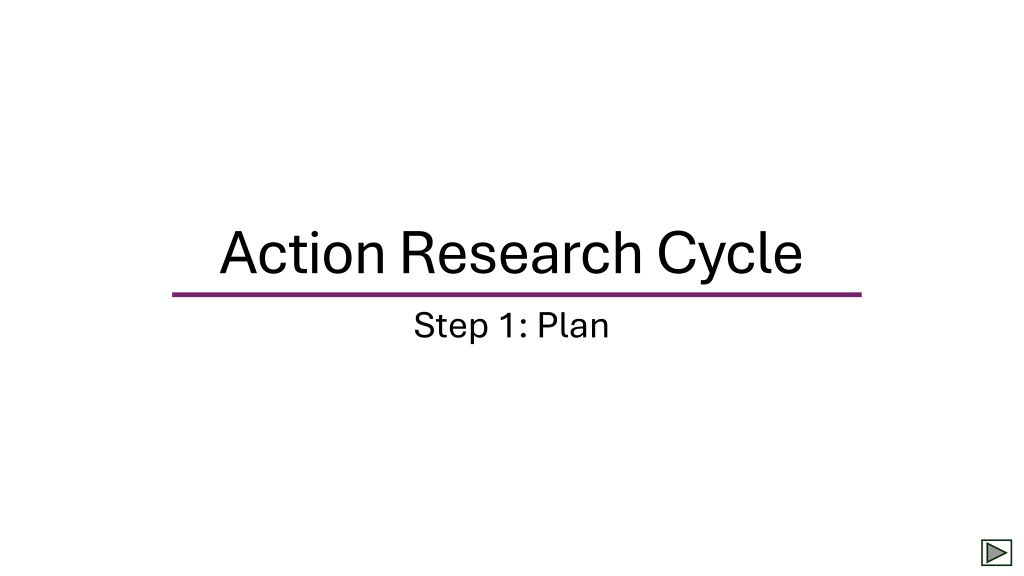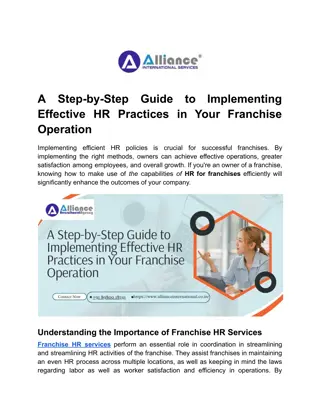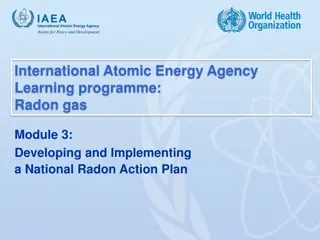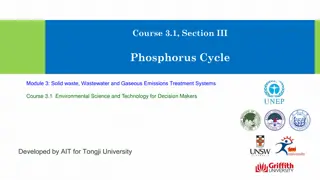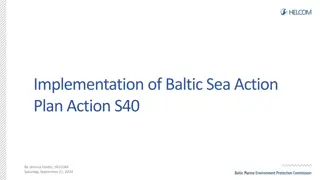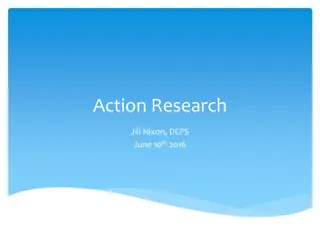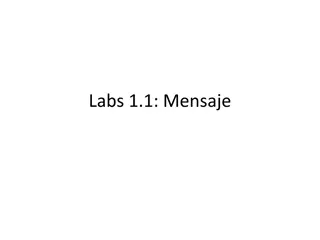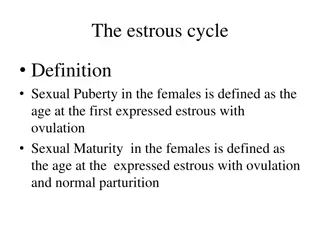Action Research Cycle Step 1: Plan and Implementing Research Questions
Action research involves identifying a problem, forming research questions, and creating a research plan. It aims to understand situations, evaluate, problem-solve, and generate new ideas. Defining a research topic is crucial, focusing on the rationale and relevance. Selecting manageable topics directly impacting student learning is essential. The process includes clarifying topics, formulating research questions, and developing actionable plans to address identified problems effectively.
- Action research
- Research questions
- Problem identification
- Student learning
- Educational organizations
Download Presentation

Please find below an Image/Link to download the presentation.
The content on the website is provided AS IS for your information and personal use only. It may not be sold, licensed, or shared on other websites without obtaining consent from the author. Download presentation by click this link. If you encounter any issues during the download, it is possible that the publisher has removed the file from their server.
E N D
Presentation Transcript
Action Research Cycle Step 1: Plan
Presentation outline 1)how to clarify your topic by identifying a problem 2)how action research questions are formulated 3)how to create an action research plan
Terms and expressions formulate a research topic rationale of your research narrow down your topic reflect data collection research findings
The goal of action research is to understand the situation, evaluate, problem-solve, or even to find new ideas and see how they work. (Andrew P. Johnson, 2012) Defining a research topic is a crucial part of action research. It is important to clearly write the rationale of your research. Rationale: Why is this topic important to study?
think about your interests, professional aims, and goals choose a topic relevant to challenges in schools, classrooms, or educational organizations choose a topic that allows you to reflect, observe, and discuss with colleagues When defining your action research topic: select a topic that you can manage, and that directly affects student learning narrow down your topic
Identifying a problem Action research is a tool that can be used to systematically study a problem area. It helps to understand what is happening and possible causes of problem. It can also be used to explore various solutions. Possible Research Problems for Action Research: The students in English class seemed to be bored and disinterested. They do their homework without making much effort. They often talk, fall asleep, or lose concentration during class. Students don t read independently outside of school. Students can t read in English. They mispronounce English words. Student attitudes toward reading are not good. Students are not doing their independent assignment creatively. Students are not good at speaking English.
Develop a research question It must be directly related to the issue or problem that you have chosen to explore. A well-formulated research question is like a roadmap for your research. The research question should help you stay focused on your research. There are certain features of good research questions. Research question can be a few sentences or a short paragraph. It has to be clear, more focused, and answerable. Features of good research questions It needs to be specific, relevant, useful, and well- designed. A good research question usually begins with why, how, or what.
Possible action research questions: What kind of speaking activities will motivate my students? What topics are generally covered in English class? What subjects are students interested in? Could you incorporate this into English teaching? What kind of reading tasks work the most effectively in my class? Who are students hero? Who do they look up to? What characteristics do these heroes have? What comprehension skills do students use to read texts? What social skills are the students acquiring through English class? What do students like to read? What types of books or genre does your class prefer? How can I stop my students from using their first language (L1) in my class? What would your students like to write about? What would make a writing class more interesting? How can I develop students reading skills by using reading techniques? What kind of listening tasks will assist my seventh- grade students to develop their listening skills?
Research Objectives The objective of action research is a statement that outlines the goals that the researcher plans to achieve in a study. The primary goal is to bring about positive and meaningful changes based on the insights gained through research. The objectives appear in studies using surveys or questionnaires and in evaluations where researchers clearly state their goals. (John W. Creswell, 2011)
Before formulating an action research plan, consider the following Preparing your resources and materials Researcher s ethics There are three areas that researchers are most interested in. 1. Searching the literature (books, research journals, databases, internet etc.,) 2. Involving others (research participants, co- teachers, team teachers, school principals, administrators, parents, university mentors etc.,) 3. Identifying and using equipment:Software and Hardware Conduct research in a moral and responsible way. Get permission from the students, pupils, teachers, the school board, district, or the individual school to undertake the research.
Before formulating an action research plan, consider the following 3. Identifying and using equipment a) Software: notepads, diaries, day books, different colored paper for different kinds of observations, memo pads, pre-prepared observation/interview/survey sheets, and whiteboards electronic b) Hardware: video-recorders, audio-cassettes,MP3 players, mini-disc, digital cameras, and mobile phones.
Creating action research plan This is a comprehensive guide to creating an action research plan. Each step is crucial and contributes to the overall success of the research. 4 3 1 2 5 Research goal Research question Context Research problem Participants 6 7 8 9 10 Data collection methods Data analysis procedure Duration of data collection Teaching strategies Display of data/findings
1. Research problem: Define the problem you want to solve. 2. Research goal: Clearly state the goal of your research. 3. Research question: This is the problem you want to solve or the question you want to answer. For example, How can I motivate my sixth-grade students to increase their time spent reading? . 4. Context: Describe the setting in which the research will take place. It could be a specific grade level, school, or district. 5. Participants: Identify the individuals who will be involved in the research. They could be students from one or multiple classrooms, or specific groups of students identified by the teacher. 6. Data collection methods: This involves using various methods such as observation, interview, survey, focus groups, and checklists to gather and analyze data. 7. Duration of data collection: This is a schedule that specifies the start and end dates for each activity and how frequently the activity will occur. 8. Teaching strategies: This outlines how the research will be conducted and what needs to be done to facilitate the research with the participants. For instance, Seventh-grade students will be taught explicitly how to use nonfiction texts in their small groups at their specific reading levels for 20 minutes each day. 9. Data analysis procedure: It includes both qualitative (textual) and quantitative (numeric) analysis. 10. Display of data/findings:Numbers, textual, table, a bar/line graph, or PowerPoint can be used to report research findings.
Figure. 1.1 Template of an Action research plan Figure. 1.2 Example of an Action research plan Many students don t like to read outside of school. Use an effective strategy to encourage students to read independently 1 Research problem Research problem 1 2 3 Research goal Research question Context Research goal 2 How can I motivate my sixth-grade students to increase their time spent reading? Research question 3 4 (grade level, school, and district) Context Participants 27 sixth grade students 4 5 (grade level, school, and district) Participants (students, teachers, parents, or school principal) Students 5 (students, teachers, parents, school principal) Data collection methods Data collection methods (research journal, field notes, conferences, interview, survey, rubrics, and checklists) 6 Survey/Questionnaire, Field notes, Checklist (research journal, field notes, conferences, interview, survey, rubrics, and checklists) 6 7 Duration of data collection Four weeks Duration of data collection 7 Teaching strategy, if necessary 8 (a log sheet) Use a log sheet to record the number of minutes and the genre of books read over a 2-week period both at home and at school Teaching strategy, if necessary 8 Data analysis procedure (a log sheet) Data analysis procedure (qualitative analysis-textual analysis and quantitative analysis-numeric analysis) 9 (qualitative analysis-textual analysis and quantitative analysis- numeric analysis) Display of data/findings Textual and numeric analysis 9 Display of data/findings 10 (numbers, textual, table, a bar/line graph, PowerPoint) Numbers and textual 10 (numbers, textual, table, a bar/line graph, PowerPoint)
Read an action research report Motivating students to read in the Supplementary readings section. Assignment 1: Create your action research plan using a Template of an Action research plan. You can do it individually, in pairs, or in a group.
References Burns, A. (2010). Doing Action Research in Language Teaching: A Guide for Practitioners. NY: Routledge. Glenda Nugent, Sakil Malik, and Sandra Hollingsworth. (2012). A Practical Guide to Action Research for Literacy Educators. Global Operations, International Reading Association. Johnson, A. (2012). A short guide to action research (4th ed.). Allyn and Bacon. John W. Creswell. (2011). Educational Research: Planning, Conducting, and Evaluating Quantitative and Qualitative Research 4th Edition. Pearson. Putman, M. & Tracy, C., (2018). Using Strategic Inquiry to Improve Teaching and Learning. SAGE Publications.
